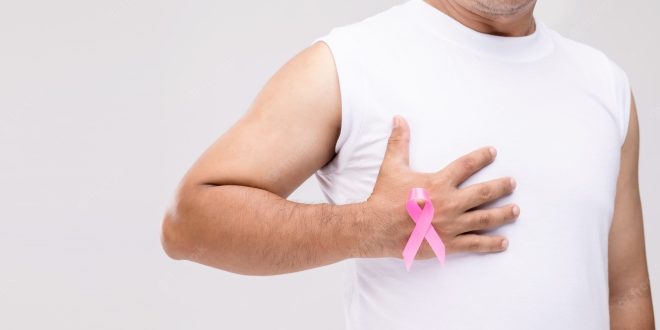By Bello Hussein Adoto
09 October 2022 |
12:00 pm
In 2019, Mathew Knowles, Beyoncé’s father, started noticing blood stains on his T-shirt. He had a bloody discharge from his nipples, and a mammogram later showed he had stage 1A breast cancer. He eventually had the affected breast tissue removed successfully. Mr Knowles’s case improved coverage of breast cancer in men and supported the need…

Mathew Knolwes
In 2019, Mathew Knowles, Beyoncé’s father, started noticing blood stains on his T-shirt. He had a bloody discharge from his nipples, and a mammogram later showed he had stage 1A breast cancer. He eventually had the affected breast tissue removed successfully.
Mr Knowles’s case improved coverage of breast cancer in men and supported the need for more awareness about the disease.
Breast cancer in men is not a common disease; only 1% of annual breast cancer cases worldwide. In Nigeria, one study reported that the percentage of men with breast cancer could be as high as 9%.
Because very few men ever get breast cancer, awareness of the disease is very low. General awareness about breast cancer could help reduce the incidence of the disease and improve the chances of recovery for men who may get it.
In sub-Saharan Africa, men with breast cancer often present late with the disease. At this point, the treatment cost could be higher and the chances of success significantly lower. Some seek unorthodox treatments, which may not resolve the condition.
This article highlights the features of breast cancer in men and what men can do to avoid the disease.
Types of breast cancer in men
The breast is a collection of cells that form fatty tissues, ducts, and lymph nodes covered by breast skin and a central coloured area around the nipple called the areola. Breast cancer affects these cells.
The American Centers for Disease Control and Prevention (CDC) highlights three common types of breast cancer in men based on the site and spread of cancer.
There is invasive ductal carcinoma, which starts in the breast’s milk ducts and then spreads outside to other tissues. This type of cancer can affect tissues outside the breast and other body parts.
Sometimes, cancer in the milk duct remains there and grows bigger but does not spread. In this case, the cancer is called ductal carcinoma in situ (DCIS).
A third common type of cancer is invasive lobular carcinoma. This type of breast cancer begins within the fatty tissues of the breast. It invades nearby breast tissues before spreading across the body.
Symptoms of breast cancer in men
Symptoms of breast cancer are similar in men and women. According to the CDC, breast cancer symptoms could be swelling or lump in the breast; dimpling or irritation of breast skin; redness or flaky skin in the breast, discharge from the nipple, and pulling in the nipple. Pain in the nipple area could also suggest breast cancer.
These symptoms are not peculiar to breast cancer. Other conditions like hormonal imbalances may cause to have these symptoms to occur. See your doctor for immediate attention if you notice any trouble in your breast.
Risk factors for breast cancer in men
Men’s risk of getting breast cancer increases with age. It is unusual for men younger than 35 to get breast cancer, but men above 50 years have a higher risk of coming down with the disease. In Nigeria, the average age of men with breast cancer is 59.
Besides old age, men who have relatives with breast cancer are four times more likely to develop the disease than those who do not.
Those who do not have relatives with breast cancer may also be at risk if they have mutations in the BRCA1 and BRCA2 genes. These genes mutations have been associated with breast cancer.
Alcohol use, radiation exposure, Klinefelter syndrome, liver disease, history of prostate cancer, and hormone replacement are possible risk factors for breast cancer in men.
Prevention of breast cancer in men
An ideal way to prevent breast cancer is to keep a healthy lifestyle and manage your risk profile. If your age is in the at-risk category, check in with your doctor regularly and report your symptoms immediately after seeing them.
Genetic testing and counselling will let you know whether you have BRCA1 and BRCA2 gene mutations and what you should do about it.
You can also discuss with your doctor if your family member has had breast or ovarian cancer or has been shown to have BRCA1 and BRCA2 gene mutations.
Treatment of breast cancer in men
Breast cancer in men is not a death sentence. Like Beyoncé’s father, any man with breast cancer can be treated successfully. How breast cancer is treated depends on the size of the breast tumour, whether it has spread beyond breast tissues, and how far it has spread.
The tumours can be removed locally with surgery or systemically with drugs (chemotherapy). Per the CDC, treatments may also involve radiation, hormone replacement, or a combination of these therapies.
 Top Naija News: Nigerian News, Breaking News Nigeria and World News Top Naija News is a daily news publication in Nigeria, delivering the latest breaking news in Nigeria and around the world.
Top Naija News: Nigerian News, Breaking News Nigeria and World News Top Naija News is a daily news publication in Nigeria, delivering the latest breaking news in Nigeria and around the world.




